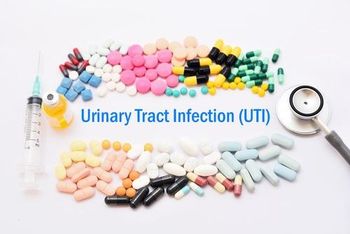
Ceftriaxone Dosing: Once or Twice Daily?
In the latest column from SIDP, clinicians discuss that along with the once-daily dosing for many indications, there are also compelling indications for twice-daily dosing.
Ceftriaxone (CRO) is a third-generation cephalosporin commonly used to treat community-acquired infections. The pharmacokinetic (PK) target for efficacy of CRO is time above the minimum inhibitory concentration (MIC) (fT>MIC). Dosing CRO to exceed the MIC throughout the dosing interval improves clinical cure threefold.1 CRO has a half-life of 6-8 hours and extensive protein binding (85-95%) which facilitate once or twice daily dosing. CRO is eliminated via renal (33-67%) and biliary excretion.2 CRO does not require dose adjustment for impaired renal or hepatic function. CRO does, however, have altered pharmacokinetics in hypoalbuminemia, substantial fluid shifts, and augmented renal clearance (ARC). 1
Guidelines recommend dosing of 1-2 grams every 12-24 hours for intra-abdominal infections, 1-2 grams daily for community-acquired pneumonia, and 1 gram daily for cystitis or pyelonephritis.3-5 In a cohort of 21 patients with acute cholangitis comparing CRO 2 grams daily to 1 gram twice daily, Toki et al observed no difference in clinical efficacy.6 Efficacy of 1 gram daily was non-inferior to 2 grams daily in a propensity-matched study of 350 patients with pneumonia (cure rate = 95% vs. 93%, p=0.009). The median body weight of 52 kg in this study may limit generalizability.7 Although dosing of CRO in obesity is not well-defined, obese patients (BMI ≥30 kg/m2) receiving CRO 1 gram daily experienced a higher rate of clinical failure (62% vs. 40%, p=0.038).8
Despite evidence demonstrating that once-daily dosing, especially 2 grams, achieves PK targets and has satisfactory clinical outcomes for many indications, there are compelling indications for twice daily dosing.
Meningitis and Ventriculitis
The recommended dose of CRO for treatment of bacterial meningitis is 4 grams divided once or twice daily.9 Subsequent literature has demonstrated that a once daily dose is suboptimal to achieve an ideal fT>MIC; the preferred regimen for CRO is 2 grams twice daily.10,11
Enterococcal endocarditis
Dual beta-lactams for Enterococcal endocarditis have gained favor as ampicillin plus CRO has been shown to be as effective as ampicillin plus gentamicin with less nephrotoxicity.12,13 Despite cephalosporins lacking in-vitro activity against Enterococci, the mechanism of synergy is saturation of penicillin-binding proteins.14 Dosing of CRO for Enterococcal endocarditis is 2 grams every 12 hours. Daily dosing regimens have failed to achieve necessary synergistic concentrations.15
Augmented Renal Clearance and Critical Illness
ARC may lead to subtherapeutic antibiotic exposure and often necessitates higher beta-lactam doses. A retrospective, propensity-matched cohort study of 212 critically ill patients with non-CNS infections comparing CRO 1 gram daily to CRO 2 grams daily found that treatment failure occurred in 17% vs. 5.7% of patients, respectively (p=0.0156).16 In a study from Ollivier et al, CRO 2 grams daily in critically ill patients with ARC (creatinine clearance ≥ 150 ml/min) was associated with an increased risk of underdosing (OR 8.8, 95% CI 2.5 to 30.7; P<0.0001). A dose of 2 grams every 12 hours demonstrated probability of target attainment of 99% for an MIC of 2 mg/L for all clearance groups.17 Therapeutic drug monitoring may be considered in critically ill patients with ARC; these patients may require CRO 2 grams every 12 hours.
References
1. Heffernan AJ, Curran RA, Denny KJ, et al. Ceftriaxone dosing in patients admitted from the emergency department with sepsis. Eur J Clin Pharmacol. 2020;77(2):207-214. doi: 10.1007/s00228-020-03001-z.
2. Ceftriaxone [package insert]. Lake Forest, IL: Hospira, Inc.; 2017.
3. Metlay JP, Waterer GW, Long AC, et al. Diagnosis and treatment of adults with community-acquired pneumonia. An official clinical practice guideline of the American Thoracic society and Infectious Diseases Society of America. Am J Respir Crit Care Med. 2019;200(7):e45-e67. doi: 10.1164/rccm.201908-1581ST.
4. Solomkin JS, Mazuski JE, Bradley JS, et al. Diagnosis and management of complicated intra-abdominal infection in adults and children: Guidelines by the surgical infection society and the Infectious Diseases Society of America. Clin Infect Dis. 2010;50(2):133-164. doi: 10.1086/649554.
5. Gupta K, Hooton TM, Naber KG, et al. International clinical practice guidelines for the treatment of acute uncomplicated cystitis and pyelonephritis in women: A 2010 update by the Infectious Diseases Society of America and the European Society for Microbiology and Infectious Diseases Clin Infect Dis. 2011;52(5):e103-e120. doi: 10.1093/cid/ciq257.
6. Toki M, Yamaguchi Y, Goto T, et al. Pharmacokinetic-pharmacodynamic comparison of ceftriaxone regimens in acute cholangitis. J Infect Chemother. 2019;25(10):780-785. doi: 10.1016/j.jiac.2019.04.006.
7. Hasegawa S, Sada R, Yaegashi M, Morimoto K, Mori T. 1g versus 2 g daily intravenous ceftriaxone in the treatment of community onset pneumonia – a propensity score analysis of data from a Japanese multicenter registry. BMC Infect Dis. 2019;19(1). doi: 10.1186/s12879-019-4552-8.
8. Barber KE, Loper JT, Morrison AR, Stover KR, Wagner JL. Impact of Obesity on Ceftriaxone Efficacy. Diseases. 2020;8(3):27. doi:10.3390/diseases8030027
9. Tunkel AR, Hartman BJ, Kaplan SL, et al. Practice guidelines for the management of bacterial meningitis. Clin Infect Dis. 2004;39(9):1267-1284. doi: 10.1086/425368.
10. Tunkel AR, Hasbun R, Bhimraj A, et al. 2017 Infectious Diseases Society of America's clinical practice guidelines for healthcare-associated ventriculitis and meningitis. Clin Infect Dis. 2017;64(6):e34-e65. doi: 10.1093/cid/ciw861.
11. Grégoire M, Dailly E, Le Turnier P, et al. High-dose ceftriaxone for bacterial meningitis and optimization of administration scheme based on nomogram. Antimicrob Agents Chemother. 2019;63(9). doi: 10.1128/aac.00634-19.
12. Fernández-Hidalgo N, Almirante B, Gavaldà J, et al. Ampicillin plus ceftriaxone is as effective as ampicillin plus gentamicin for treating Enterococcus faecalis infective endocarditis. Clin Infect Dis. 2013;56(9):1261-1268. doi: 10.1093/cid/cit052.
13. Gavalda J, Len O, Bou G, et al. Brief communication: Treatment of Enterococcus faecalis endocarditis with ampicillin plus ceftriaxone. Ann Internal Med. 2007;146(8):574-579. doi: 10.7326/0003-4819-146-8-200704170-00008.
14. Baddour LM, Wilson WR, Bayer AS, Fowler VG Jr, Tleyjeh IM, Rybak MJ, Barsic B, Lockhart PB, Gewitz MH, Levison ME, Bolger AF, Steckelberg JM, Baltimore RS, Fink AM, O'Gara P, Taubert KA; American Heart Association Committee on Rheumatic Fever, Endocarditis, and Kawasaki Disease of the Council on Cardiovascular Disease in the Young, Council on Clinical Cardiology, Council on Cardiovascular Surgery and Anesthesia, and Stroke Council. Infective Endocarditis in Adults: Diagnosis, Antimicrobial Therapy, and Management of Complications: A Scientific Statement for Healthcare Professionals From the American Heart Association. Circulation. 2015 Oct 13;132(15):1435-86. doi: 10.1161/CIR.0000000000000296.
15. Herrera-Hidalgo L, de Alarcón A, López-Cortes LE, et al. Is once-daily high-dose ceftriaxone plus ampicillin an alternative for Enterococcus faecalis infective endocarditis in outpatient parenteral antibiotic therapy programs? Antimicrob Agents Chemother. 2020;65(1). doi: 10.1128/AAC.02099-20.
16. Ackerman A, Zook NR, Siegrist JF, Brummitt CF, Cook MM, Dilworth TJ. Comparison of clinical outcomes among intensive care unit patients receiving one or two grams of ceftriaxone daily. Antimicrob Agents Chemother. 2020;64(6). doi: 10.1128/AAC.00066-20.
17. Ollivier J, Carrié C, D’houdain N, et al. Are standard dosing regimens of ceftriaxone adapted for critically ill patients with augmented creatinine clearance? Antimicrob Agents Chemother. 2019;63(3). doi: 10.1128/aac.02134-18.stylefix
Newsletter
Stay ahead of emerging infectious disease threats with expert insights and breaking research. Subscribe now to get updates delivered straight to your inbox.

































































































































































































































































































